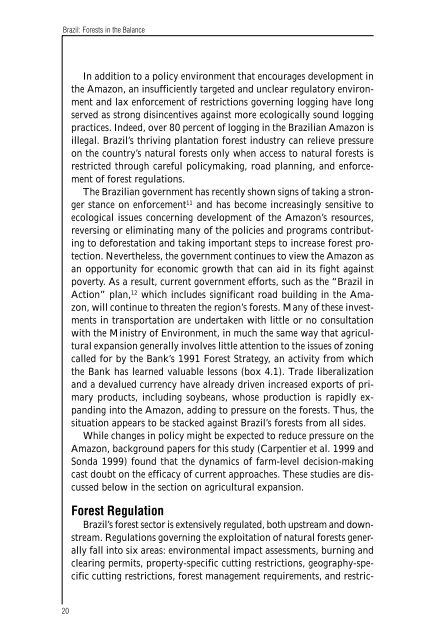Download Report - Independent Evaluation Group - World Bank
Download Report - Independent Evaluation Group - World Bank
Download Report - Independent Evaluation Group - World Bank
Create successful ePaper yourself
Turn your PDF publications into a flip-book with our unique Google optimized e-Paper software.
Brazil: Forests in the Balance<br />
In addition to a policy environment that encourages development in<br />
the Amazon, an insufficiently targeted and unclear regulatory environment<br />
and lax enforcement of restrictions governing logging have long<br />
served as strong disincentives against more ecologically sound logging<br />
practices. Indeed, over 80 percent of logging in the Brazilian Amazon is<br />
illegal. Brazil’s thriving plantation forest industry can relieve pressure<br />
on the country’s natural forests only when access to natural forests is<br />
restricted through careful policymaking, road planning, and enforcement<br />
of forest regulations.<br />
The Brazilian government has recently shown signs of taking a stronger<br />
stance on enforcement 11 and has become increasingly sensitive to<br />
ecological issues concerning development of the Amazon’s resources,<br />
reversing or eliminating many of the policies and programs contributing<br />
to deforestation and taking important steps to increase forest protection.<br />
Nevertheless, the government continues to view the Amazon as<br />
an opportunity for economic growth that can aid in its fight against<br />
poverty. As a result, current government efforts, such as the “Brazil in<br />
Action” plan, 12 which includes significant road building in the Amazon,<br />
will continue to threaten the region’s forests. Many of these investments<br />
in transportation are undertaken with little or no consultation<br />
with the Ministry of Environment, in much the same way that agricultural<br />
expansion generally involves little attention to the issues of zoning<br />
called for by the <strong>Bank</strong>’s 1991 Forest Strategy, an activity from which<br />
the <strong>Bank</strong> has learned valuable lessons (box 4.1). Trade liberalization<br />
and a devalued currency have already driven increased exports of primary<br />
products, including soybeans, whose production is rapidly expanding<br />
into the Amazon, adding to pressure on the forests. Thus, the<br />
situation appears to be stacked against Brazil’s forests from all sides.<br />
While changes in policy might be expected to reduce pressure on the<br />
Amazon, background papers for this study (Carpentier et al. 1999 and<br />
Sonda 1999) found that the dynamics of farm-level decision-making<br />
cast doubt on the efficacy of current approaches. These studies are discussed<br />
below in the section on agricultural expansion.<br />
Forest Regulation<br />
Brazil’s forest sector is extensively regulated, both upstream and downstream.<br />
Regulations governing the exploitation of natural forests generally<br />
fall into six areas: environmental impact assessments, burning and<br />
clearing permits, property-specific cutting restrictions, geography-specific<br />
cutting restrictions, forest management requirements, and restric-<br />
20

















